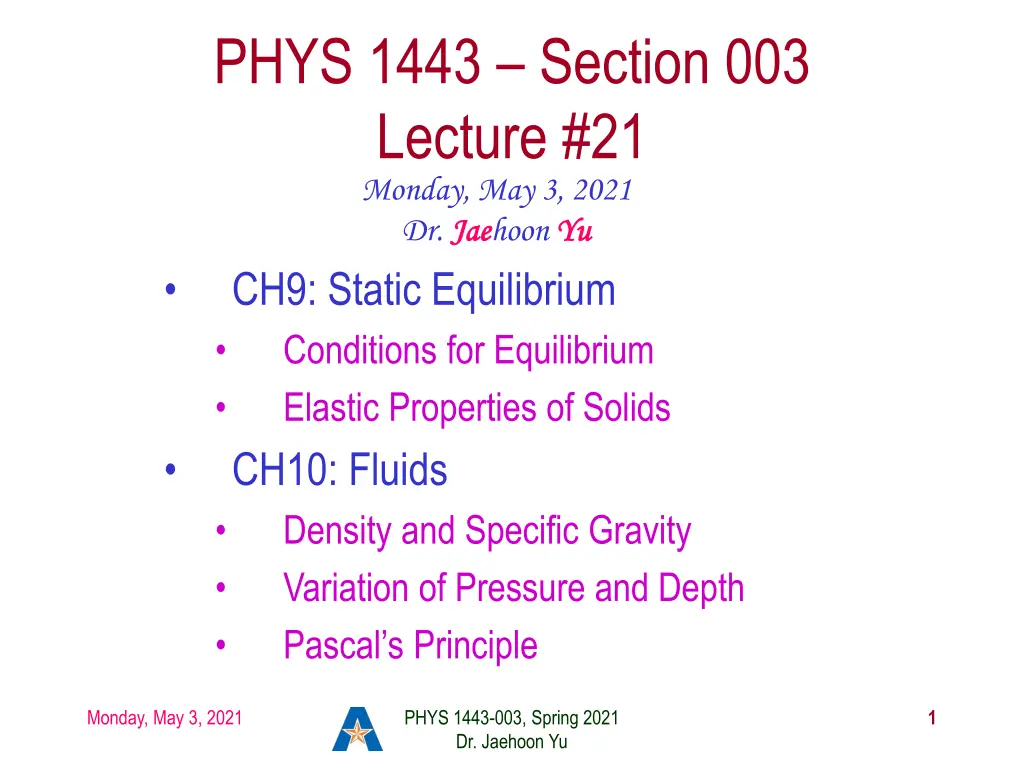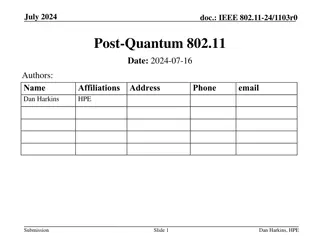
Understanding Static Equilibrium Conditions in Physics
Explore the concept of static equilibrium in physics, discussing conditions for equilibrium and the importance of balancing forces and torques to maintain stability. Learn about translational equilibrium and rotational equilibrium, along with practical examples illustrating these principles.
Download Presentation

Please find below an Image/Link to download the presentation.
The content on the website is provided AS IS for your information and personal use only. It may not be sold, licensed, or shared on other websites without obtaining consent from the author. If you encounter any issues during the download, it is possible that the publisher has removed the file from their server.
You are allowed to download the files provided on this website for personal or commercial use, subject to the condition that they are used lawfully. All files are the property of their respective owners.
The content on the website is provided AS IS for your information and personal use only. It may not be sold, licensed, or shared on other websites without obtaining consent from the author.
E N D
Presentation Transcript
PHYS 1443 Section 003 Lecture #21 Monday, May 3, 2021 Dr. Jae Jaehoon Yu CH9: Static Equilibrium Conditions for Equilibrium Elastic Properties of Solids CH10: Fluids Density and Specific Gravity Variation of Pressure and Depth Pascal s Principle Yu Monday, May 3, 2021 PHYS 1443-003, Spring 2021 Dr. Jaehoon Yu 1
Announcements Reading assignments: CH 9.5, 9.6 and 9.7 The final comprehensive exam: 2 4:30pm, Monday, May 10 on Quest Roll call begins at 1:45pm on Monday, May 10! Covers CH1.1 through CH10.5 + math refresher No class this Wednesday, May 5 BYOF: You may bring one 8.5x11.5 sheet (front and back) of handwritten formulae and values of constants for the test No derivations, word definitions, setups or solutions of any problems, figures, pictures, diagrams or arrows, etc! Must email me the photos of front and back of the formula sheet, including the blank at jaehoonyu@uta.edu no later than 11:00am the day of the test The subject of the email should be the same as your file name File name must be FS-E4-LastName-FirstName-SP21.pdf Once submitted, you cannot change, unless I ask you to delete part of the sheet! Please fill out and submit the feedback survey ASAP (only 30!) Monday, May 3, 2021 PHYS 1443-003, Spring 2021 Dr. Jaehoon Yu 2
Conditions for Equilibrium What do you think the term An object is at its equilibrium means? Either the object is at rest (Static Equilibrium) or its center of mass is moving at a constant velocity (Dynamic Equilibrium). When do you think an object is at its equilibrium? 0 Translational Equilibrium: Equilibrium in linear motion Is this it? The above condition is sufficient for a point-like object to be at its translational equilibrium. However, for an object with size this is not sufficient. One more condition is needed. What is it? Let s consider two forces equal in magnitude but in opposite direction acting on a rigid object as shown in the figure. What do you think will happen? F F d CM The object will rotate about the CM. Since the net torque acting on the object about a rotational axis is not 0. For an object to be at its static equilibrium, the object should not have linear or angular speed. 0 d - -F F = = 0 0 CM v Monday, May 3, 2021 PHYS 1443-003, Spring 2021 Dr. Jaehoon Yu 3
More on Conditions for Equilibrium To simplify the problem, we will only deal with forces acting on x-y plane, giving torque only along z-axis. What do you think the conditions for equilibrium be in this case? The six possible equations from the two vector equations turns to three equations. 0 0 x F = z = 0 AND y F = What happens if there are many forces exerting on an object? If an object is at its translational static equilibrium, and if the net torque acting on the object is 0 about one axis, the net torque must be 0 about any arbitrary axis. Why is this true? Because the object is not moving not moving, no matter what the rotational axis is, there should not be any motion. It is simply a matter of mathematical manipulation. r r O O r r5 5 Monday, May 3, 2021 PHYS 1443-003, Spring 2021 Dr. Jaehoon Yu 4
How do we solve a static equilibrium problem? 1. Select the object to which the equations for equilibrium are to be applied. 2. Identify all the forces and draw a free-body diagram with them indicated on it & with their directions and locations properly indicated 3. Choose a convenient set of x and y axes and write down the force equation for each x and y component with correct signs. 4. Establish the equations that specify the balance of forces at equilibrium. Set the net force in the x and y directions equal to 0. 5. Select the most optimal rotational axis for torque calculations Selecting the axis such that the torque from one or more of the unknown forces become 0 makes the problem much easier to solve. 6. Establish the torque equation with proper signs. 7. Solve the force and torque equations for the desired unknown quantities. Monday, May 3, 2021 PHYS 1443-003, Spring 2021 Dr. Jaehoon Yu 5
Example for Mechanical Equilibrium A uniform 40.0 N board supports the father and the daughter each weighing 800 N and 350 N, respectively, and is not moving. If the support (or fulcrum) is under the center of gravity of the board, and the father is 1.00 m from the center of gravity (CoG), what is the magnitude of the normal force n n exerted on the board by the support? 1m x Since there is no linear motion, this system is in its translational equilibrium Fx 0 = y F B M g 800 0 . 40 + = n n F D MFg g MDg g MBg g = n = = 0 M g 350 + M g 1190 F D n N Therefore, the magnitude of the normal force Determine where the child should sit to balance the system. The net torque about the fulcrum by all the forces are Therefore, to balance the system the daughter must sit at = 0 g + . 1 g MD = MB + 00 0 MF g x 0 n M g 800 x = . 1 00 F m = . 1 = 00 . 2 29 m m M g 350 D Monday, May 3, 2021 PHYS 1443-003, Spring 2021 Dr. Jaehoon Yu 6
Example for Mech. Equilibrium Contd Determine the position of the child to balance the system for different position of axis of rotation. Rotational axis 1m x n n x/2 F D The net torque about the axis of rotation by all the forces are MFg g MFg g MBg g ( . 1 ) 2 / = 0 = MB + + MD n / 2 / 2 00 g x g x MF g x / 2 x n MB ( M M = = + + + M g M g M ( . 1 g D x g Since the normal force is B / + F D ) 2 / + x 0 = 00 ) = 2 M 00 MF g M g M g D x 2 g x g The net torque can be rewritten MD + / 2 / g x B g F . 1 F What do we learn? M g 800 x Therefore = . 1 00 F m = . 1 = No matter where the rotation axis is, net effect of the torque is identical. 00 . 2 29 m m M g 350 D Monday, May 3, 2021 PHYS 1443-003, Spring 2021 Dr. Jaehoon Yu 7
Ex. Human Forearm A person holds a 50.0N sphere in his hand. The forearm is horizontal. The biceps muscle is attached 3.00 cm from the joint, and the sphere is 35.0cm from the joint. Find the upward force exerted by the biceps on the forearm and the downward force exerted by the upper arm, acting on the joint. Neglect the weight of the forearm. Since the system is in equilibrium, from the translational equilibrium condition 0 = F B = = 0 F FB B d x F F O = 0 mg F mg l l mg mg U + y F FU U mg l = 0 F F d l From the rotational equilibrium condition U B = FB l 50 d Thus, the force exerted by the biceps muscle is mg 0 . 35 0 . = = = 583 F N B . 3 00 = d = FB = F mg Force exerted by the upper arm is 583 50 0 . 533 N U Monday, May 3, 2021 PHYS 1443-003, Spring 2021 Dr. Jaehoon Yu 8
Example: Ladder Balance A 5.0 m long ladder leans against a wall at a point 4.0m above the ground. The ladder is uniform and has mass 12.0kg. Assuming the wall is frictionless (but ground is not), determine the forces exerted on the ladder by the ground and the wall. First the translational equilibrium, using components F F = F FW W FBD = x F 0 mg g Gx W F FGy O Gy = + mg F = F 0 F FGx Gy y Gx Thus, the y component of the force by the ground is F = The length x0 is, from Pythagorian theorem mg = 12.0 9.8 = 118 N N Gy = = 2 2 5.0 4.0 3.0 x m 0 Monday, May 3, 2021 PHYS 1443-003, Spring 2021 Dr. Jaehoon Yu 9
Example contd = + = 02 4.0 mg x F 0 From the rotational equilibrium O W Thus, the force exerted on the ladder by the wall is mg x = 4.0 02 118 1.5 = = F 44 N W 4.0 The x component of the force by the ground is = = = = 44 F F N 0 F F F Solve for FGx Gx W x Gx W Thus, the force exerted on the ladder by the ground is = + = + 2 2 2 2 F 44 118 F F 130N F F G Gx Gy 1 118 The angle between the ground force to the floor Gy = 1 = = o tan tan 70 44 Gx Monday, May 3, 2021 PHYS 1443-003, Spring 2021 Dr. Jaehoon Yu 10
Elastic Properties of Solids We have been assuming that the objects do not change their shapes when external forces are exerting on it. It this realistic? No. In reality, objects get deformed as external forces act on it, though the internal forces resist the deformation as it takes place. Deformation of solids can be understood in terms of Stress and Strain Stress: The amount of the deformation force per unit area the object is subjected Strain: The measure of the degree of deformation It is empirically known that for small stresses, strain is proportional to stress stress strain The constants of proportionality are called the Elastic Modulus Elastic Modulus 1. 2. 3. Young s modulus: The measure of the elasticity in length Shear modulus: The measure of the elasticity in area Bulk modulus: The measure of the elasticity in volume Three types of Elastic Modulus Monday, May 3, 2021 PHYS 1443-003, Spring 2021 Dr. Jaehoon Yu 11
Elastic Limit and Ultimate Strength The elastic limit: The limit of elasticity beyond which an object cannot recover its original shape or the maximum stress that can be applied to a substance before it becomes permanently deformed The ultimate strength: The maximum force that can be applied on the object before breaking it Monday, May 3, 2021 PHYS 1443-003, Spring 2021 Dr. Jaehoon Yu 12
Youngs Modulus Let s consider a long bar with cross sectional area A and initial length Li. Li Lf=Li+ L F Fex ex F Fex ex After the stretch F Fex ex=F =Fin in A:cross sectional area Fex L Tensile stress Tensile strain Tensile Strain Tensile Stress iL A F Used to characterize a rod or wire stressed under tension or compression Tensile Stress ex Y Young s Modulus is defined as A = L Tensile Strain L i What is the unit of Young s Modulus? 1. Force per unit area For a fixed external force, the change in length is proportional to the original length The necessary force to produce the given strain is proportional to the crosssectional area Experimental Observations 2. Monday, May 3, 2021 PHYS 1443-003, Spring 2021 Dr. Jaehoon Yu 13
Bulk Modulus Bulk Modulus characterizes the response of a substance to uniform squeezing or reduction of pressure. F F F F F F After the pressure change V V F F Normal Force F Volume stress =pressure If the pressure on an object changes by P= F/A, the object will undergo a volume change V. = Pressure Surface Area the force applies A F P Bulk Modulus is defined as Because the change of volume is reverse to change of pressure. Volume Stress A = = B V V Volume Strain i V i V Compressibility is the reciprocal of Bulk Modulus Monday, May 3, 2021 PHYS 1443-003, Spring 2021 Dr. Jaehoon Yu 14
Example for Solids Elastic Property A solid brass sphere is initially under normal atmospheric pressure of 1.0x105N/m2. The sphere is lowered into the ocean to a depth at which the pressures is 2.0x107N/m2. The volume of the sphere in air is 0.5m3. By how much its volume change once the sphere is submerged? P = B Since bulk modulus is V iV PV = i V The amount of volume change is B From table 12.1, bulk modulus of brass is 8.0x1010 N/m2 = = 0 . 1 7 5 7 The pressure change P is 0 . 2 10 10 0 . 2 10 P P P f i Therefore the resulting volume change V isDV =Vf-Vi= -2.0 107 0.5 = -1.2 10-4m3 8.0 1010 The volume has decreased. Monday, May 3, 2021 PHYS 1443-003, Spring 2021 Dr. Jaehoon Yu 15
Fluid and Pressure What are the three phases of matter? Solid, Liquid and Gas Using the time it takes for a particular substance to change its shape in reaction to external forces. A collection of molecules that are randomly arranged and loosely bound by the force between them or by an external container. We will first learn about mechanics of fluid at rest, fluid statics. How do you distinguish them? What is a fluid? In what ways do you think fluid exerts stress on an object submerged in it? Fluid cannot exert shearing or tensile stress. Thus, the only force the fluid exerts on an object immersed in it is the force perpendicular to the surface of the object. This force by the fluid on an object usually is expressed in the form of the force per unit area at the given depth, or the pressure, defined as Expression of pressure for an infinitesimal area dA by the force dF is P F P A dF dA Special SI unit for pressure is Pascal Note that pressure is a scalar quantity because it s the magnitude of the force on surface area A. = What is the unit and the dimension of pressure? Unit:N/m2 Dim.: [M][L-1][T-2] Pa 2 1 1 / N m Monday, May 3, 2021 PHYS 1443-003, Spring 2021 Dr. Jaehoon Yu 16
Density and Specific Gravity Density, (rho), of an object is defined as mass per unit volume V 3 /m kg [ ML M Unit? Dimension? 3 ] Specific gravity of a substance is defined as the ratio of the density of the substance to that of the water at 4.0 oC ( H2O=1.00g/cm3). SG Unit? Dimension? SG SG None None Sink in the water Float on the surface substance H O 2 1 1 What do you think would happen of a substance in the water dependent on SG? Monday, May 3, 2021 PHYS 1443-003, Spring 2021 Dr. Jaehoon Yu 17
Example for Pressure The mattress of a waterbed is 2.00m long by 2.00m wide and 30.0cm deep. a) Find the weight of the water in the mattress. The volume density of water at the normal condition (4oC and 1 atm) is 1000kg/m3. So, the total mass of the water in the mattress is m Therefore, the weight of the water in the mattress is W b) Find the pressure exerted by the water on the floor when the bed rests in its normal position, assuming the entire lower surface of the mattress makes a contact with the floor. = = . 0 . 1 = WV 3 1000 . 2 00 . 2 00 300 20 10 kg M = mg . 1 = 8 . 9 . 1 = 3 4 20 10 18 10 N Since the surface area of the mattress is 4.00 m2, the pressure exerted on the floor is F mg 4 . 1 18 10 P = = = = 3 . 2 95 N / m2 10 A A . 4 00 Monday, May 3, 2021 PHYS 1443-003, Spring 2021 Dr. Jaehoon Yu 18
Variation of Pressure and Depth Water pressure increases as a function of depth, and the air pressure decreases as a function of altitude. Why? It seems that the pressure has a lot to do with the total mass of the fluid above the object that puts the weight on the object. Let s imagine the liquid contained in a cylinder with height h and the cross-sectional area A immersed in a fluid of density at rest, as shown in the figure, and the system is in its equilibrium. P0A h Mg g If the liquid in the cylinder is the same substance as the fluid, the mass of the liquid in the cylinder is Mg A P PA 0 Since the system is in its equilibrium PA = = A V P Ah M PA = = Ahg 0 0 = + The pressure at the depth h below the surface of the fluid open to the atmosphere is greater than the atmospheric pressure by gh. Therefore, we obtain P gh P 0 Atmospheric pressure P0 is atm . 1 00 . 1 = 5 013 10 Pa Monday, May 3, 2021 PHYS 1443-003, Spring 2021 Dr. Jaehoon Yu 19
Pascals Principle and Hydraulics A change in the pressure applied to a fluid is transmitted to every point of the fluid and to the walls of the container, undiminished. = + P P gh What happens if P0is changed? 0 The resultant pressure P at any given depth h increases as much as the change in P0. This is the principle behind hydraulic pressure. How? Since the pressure change caused by the the force F1 applied onto the area A1 is transmitted to the F2 on an area A2. In other words, the force gets multiplied by the ratio of the areas A2/A1 and is transmitted to the force F2 on the surface. No, the actual displaced volume of the fluid is the same. And the work done by the forces are still the same. A2 F F F1A1 d1 = = 1 2 P d2 A A F2 1 2 A = 2F A F Therefore, the resultant force F2 is 1 2 1 This seems to violate some kind of conservation law, doesn t it? d = 1F F 1 2 d 2 Monday, May 3, 2021 PHYS 1443-003, Spring 2021 Dr. Jaehoon Yu 20
Example for Pascals Principle In a car lift used in a service station, compressed air exerts a force on a small piston that has a circular cross section and a radius 5.00cm. This pressure is transmitted by a liquid to a piston that has a radius of 15.0cm. What force must the compressed air exert to lift a car weighing 13,300N? What air pressure produces this force? Using Pascal s principle, one can deduce the relationship between the forces, the force exerted by the compressed air is ( ) ( ) 0.15 2 0.05 AF A = 4 3 1 = = 1.33 10 1.48 10 N 1 F 2 2 2 Therefore, the necessary pressure of the compressed air is F 3 . 1 48 10 = P = . 1 = 1 5 88 10 Pa ( ) 2 A 1 Monday, May 3, 2021 PHYS 1443-003, Spring 2021 Dr. Jaehoon Yu 21
Example for Pascals Principle Estimate the force exerted on your eardrum due to the water above when you are swimming at the bottom of the pool with a depth 5.0 m. Assume the surface area of the eardrum is 1.0cm2. We first need to find out the pressure difference that is being exerted on the eardrum. Then estimate the area of the eardrum to find out the force exerted on the eardrum. Since the outward pressure in the middle of the eardrum is the same as the normal air pressure gh W = 8 . 9 1000 = P 0 P 0 . 5 = 4 9 . 4 10 Pa Estimating the surface area of the eardrum at 1.0cm2=1.0x10-4 m2, we obtain ( )A P P 0 = 9 . 4 0 . 1 4 4 F 10 10 9 . 4 N Monday, May 3, 2021 PHYS 1443-003, Spring 2021 Dr. Jaehoon Yu 22
Example for Pascals Principle Water is filled to a height H behind a dam of width w. Determine the resultant force exerted by the water on the dam. Since the water pressure varies as a function of depth, we will have to do some calculus to figure out the total force. h H The pressure at the depth h is = dy y ( ) y = gh g H P The infinitesimal force dF exerting on a small strip of dam dy is = = ( )wdy g H y dF PdA Therefore the total force exerted by the water on the dam is = y H y H = 1 2 ( ) 1 2 = = g H y wdy 2 = gw Hy 2 = gwH y F = 0 y 0 y Monday, May 3, 2021 PHYS 1443-003, Spring 2021 Dr. Jaehoon Yu 23
Congratulations!!!! You all are impressive and have done very well, over COVID!!! I certainly had a lot of fun with ya ll and am truly proud of you! Good luck with your exam!!! Have a safe, fruitful summer!! Monday, May 3, 2021 PHYS 1443-003, Spring 2021 Dr. Jaehoon Yu 24






















